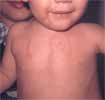Photoclinic: Phytophotodermatitis
The mother of a young child was concerned about these hyperpigmented streaks that had appeared on her son's upper chest during the previous 2 weeks. Initially, the streaks were erythematous. They were completely asymptomatic, and the child was otherwise healthy and taking no medications.

The mother of a young child was concerned about these hyperpigmented streaks that had appeared on her son's upper chest during the previous 2 weeks. Initially, the streaks were erythematous. They were completely asymptomatic, and the child was otherwise healthy and taking no medications.
The child had been playing outdoors without a shirt for the past couple of weeks. On close questioning, the mother recalled seeing her son playing with lemon slices from a lemonade jar.
The history and pattern of the rash suggested phytophotodermatitis, writes Elias Milgram, MD, of Miami. This photosensitivity reaction results from skin contact with certain plants followed by exposure to sunlight. Both components (plant and light) are required for the reaction.
Phytophotodermatitis is generally based on nonimmunologic mechanisms; it often occurs after first exposure. The reaction is limited to the site of contact with the photosensitizing agent. The most common manifestation is prominent pigmentary changes, which may last for weeks or months. This postinflammatory hyperpigmentation often appears in linear and odd patterns, such as "handprints." The color of these lesions may resemble a bruise and, in certain patients, may suggest child abuse. For the astute observer, however, this will rarely be a concern.
The hyperpigmentation results from a melanocytic response caused by furocoumarins (psoralens)--the major photoreactive compounds in plant oils. When exposed to long-wave UV-A light, furocoumarins absorb energy and become activated. Contact of activated furocoumarins with skin can cause epidermal cell nucleic acid damage when no oxygen is present (type I reaction) or cellular membrane damage when oxygen is present (type II reaction).
Commonly implicated plants include celery, giant hogweed, angelica, parsnip, fennel, dill, anise, parsley, lime, lemon, mango, rue, fig, mustard, scurf pea, and chrysanthemum.1-4 Oil of bergamot, in particular, when used in perfume can cause a specific type of phytophotodermatitis (perfume-induced berloque dermatitis), in which areas of affected skin correspond to areas exposed to perfume.
Symptoms usually develop within 24 to 48 hours after sunlight exposure. Patients may have initial burning erythema followed by blisters. Edema and bullae formation can occur in severe cases. Pruritus is uncommon; when present, consider an allergic phytodermatitis (eg, Toxicodendron dermatitis).
Phytophotodermatitis is generally self-limited; it usually resolves within a week if further insult is avoided. When necessary, mild reactions may be managed with cool, wet dressings and topical corticosteroids. Children with severe reactions may require NSAIDs. Application of 4% hydroquinone cream once or twice daily for several weeks may lessen hyperpigmentation in patients older than 12 years.5 Often, the child is asymptomatic by the time he or she sees a physician, and treatment is for cosmesis only.
References:
REFERENCES:
1.
Gross TP, Ratner L, de Rodriguez O, et al. An outbreak of phototoxic dermatitis due to limes.
Am J Epidemiol.
1987;125:509-514.
2.
Lovell CR. Phytodermatitis.
Clin Dermatol.
1997;15:607-613.
3.
Sasseville D. Phytodermatitis.
J Cutan Med Surg.
1999;3:263-279.
4.
Coffman K, Boyce WT, Hansen RC. Phytophotodermatitis simulating child abuse.
Am J Dis Child.
1985;139:239-240.
5.
Shepherd S, Lydon TJ. Plant poisoning, phytophototoxins. Emedicine. Available at:
http://www.emedicine.com/emerg/topic446.htm
. Accessed February 17, 2006.
Recognize & Refer: Hemangiomas in pediatrics
July 17th 2019Contemporary Pediatrics sits down exclusively with Sheila Fallon Friedlander, MD, a professor dermatology and pediatrics, to discuss the one key condition for which she believes community pediatricians should be especially aware-hemangiomas.